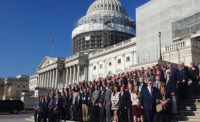I can’t imagine being a small business ownerthat’s worked hard to recruit, train and reward strong performers only to be told by the federal government that your ways won’t work.
Wholesale distribution is a complex system of connecting the right product(s) with the customer in as timely a manner as possible. Virtually every one of ASA’s distributor members prides themselves on putting the customer first with inventory and service needs — essentially doing what it takes to get the job done.
Manufacturers rely on their partners in distribution to represent their products well, assist customers on specific needs and, at the end of the day, sell more of their products. Distributors heavily invest in a skilled salesforce to gain business with ears to the ground and representing the company and its services before area developers, industrial customers, governments, home owners and many others in the diverse customer base that the PHCP-PVF industry serves.
According to the magazine Inc., “Sales incentive programs can have an enormous impact on the bottom line and on future growth of the business. Executing a well-designed sales compensation plan can help companies create a sales culture of high performance where individual goals are aligned with those of the larger organization.”
When the Department of Labor’s new overtime regulations go into effect on Dec. 1, employees making up to $47,476 will be eligible to receive overtime. Millions will be impacted, but for many, in ways they might not expect. If the DOL has its way, small businesses like some members of ASA can do one of four things:
1) Raise employee pay to the new threshold to avoid paying overtime;
2) Pay them overtime if they qualify;
3) Reduce or eliminate overtime; or
4) Hire more employees to get the work completed.
Fortunately for some, the rule was not updated to impact outside sales positions, which, along with educators, select professionals and IT workers are exempt. What the DOL fails to recognize is distribution and sales aren’t always 9-5 operations and often deals get done outside normal business hours with a robust commission system in place to reward the seller for a job well-done.
According to ASA’s 2014 Employee Compensation Report, ASA distributor members paid their typical inside salesperson a base salary of $42,976 — with bonus that figure increased to about $50,000. According to the new rules, nondiscretionary bonuses and incentive payments will be permitted to satisfy up to 10% of the standard salary test requirement.
Many in inside sales, including showroom consultants, will fall below the new range qualifying for overtime. The same can be said for a typical warehouse supervisor, likely one who’s been promoted from an hourly wage. The solution, painful as it may be for the employer, is to raise wages above the overtime threshold, cut hours or hire
more employees.
But the concern then is what happens to the incentive system you’ve put into place? Will employees be as productive now if they no longer have the goals to strive for? Will a job that normally takes eight hours suddenly require nine to complete?
Come Dec. 1 these decisions must be made. Is there a legislative solution? One would require the president’s signature and the other could put a government shutdown into play just before national elections. Neither seems likely.
Employers should seek as many resources as possible. Go directly to the source at the Department of Labor, Wage and Hour Division and leave no stone unturned in getting the answers to the questions you may have.
ASA continues to fight this issue as a member of the Partnership to Protect Workplace Opportunity by educating elected officials of the disaster that this rule means to so many small businesses.





